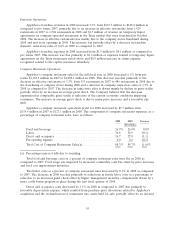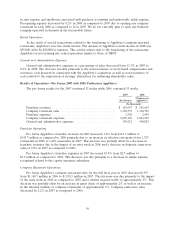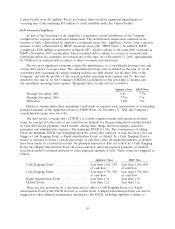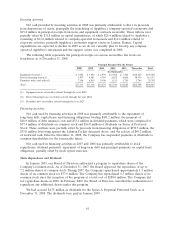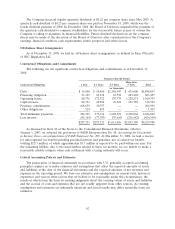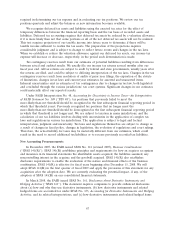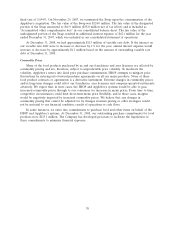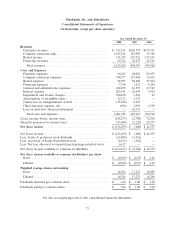IHOP 2008 Annual Report Download - page 78
Download and view the complete annual report
Please find page 78 of the 2008 IHOP annual report below. You can navigate through the pages in the report by either clicking on the pages listed below, or by using the keyword search tool below to find specific information within the annual report.more frequently if the Company believes indicators of impairment exist. Such indicators include, but
are not limited to, events or circumstances such as a significant adverse change in the business climate,
unanticipated competition, a loss of key personnel, adverse legal or regulatory developments, or a
significant decline in the market price of the Company’s common stock.
In the process of the Company’s annual impairment review, the Company primarily uses the
income approach method of valuation that includes the discounted cash flow method as well as other
generally accepted valuation methodologies to determine the fair value of our intangible assets.
Significant assumptions used to determine fair value under the discounted cash flows model include
future trends in sales, operating expenses, overhead expenses, depreciation, capital expenditures, and
changes in working capital along with an appropriate discount rate. Additional assumptions are made
as to proceeds to be received from future franchising of company-operated restaurants. Step one of the
impairment test compares the fair value of each of our reporting units to its carrying value. If the fair
value is in excess of the carrying value, no impairment exists. If the step one test does indicate an
impairment, step two must take place. Under step two, the fair value of the assets and liabilities of the
reporting unit are estimated as if the reporting unit were acquired in a business combination. The
excess of the fair value of the reporting unit over the carrying amounts assigned to its assets and
liabilities is the implied fair value of the goodwill, to which the carrying value of the goodwill must be
adjusted. The fair value of all reporting units is then compared to the current market value of the
Company’s common stock to determine if the fair values estimated in the impairment testing process
are reasonable in light of the current market value.
Leases
Our restaurants are located on (i) sites owned by us, (ii) sites leased by us from third parties and
(iii) sites owned or leased by franchisees. At the inception of the lease, each property is evaluated to
determine whether the lease will be accounted for as an operating or capital lease in accordance with
the provisions of Statement of Financial Accounting Standards No. 13, Accounting for Leases
(‘‘SFAS 13’’) and subsequent amendments.
The lease term used for straight-line rent expense is calculated from the date we obtain possession
of the leased premises through the lease termination date. Prior to January 2, 2006, we capitalized rent
expense from possession date through construction completion and reported the related asset in
property and equipment. Capitalized rent was amortized through depreciation and amortization
expense over the estimated useful life of the related assets limited to the lease term. Straight-line rent
recorded during the preopening period (construction completion through restaurant open date) was
recorded as expense. Commencing January 2, 2006, we expense rent from possession date through
restaurant open date, in accordance with FASB Staff Position No. 13-1, Accounting for Rental Costs
Incurred during a Construction Period. Once a restaurant opens for business, we record straight-line rent
over the lease term plus contingent rent to the extent it exceeded the minimum rent obligation per the
lease agreement. We use a consistent lease term when calculating depreciation of leasehold
improvements, when determining straight-line rent expense and when determining classification of our
leases as either operating or capital.
There is potential for variability in the rent holiday period, which begins on the possession date
and ends on the restaurant open date, during which no cash rent payments are typically due under the
terms of the lease. Factors that may affect the length of the rent holiday period generally relate to
construction related delays. Extension of the rent holiday period due to delays in restaurant opening
will result in greater preopening rent expense recognized during the rent holiday period and lesser
occupancy expense during the rest of the lease term (post-opening).
For leases that contain rent escalations, we record the total rent payable during the lease term, as
determined above, on the straight-line basis over the term of the lease (including the rent holiday
64



